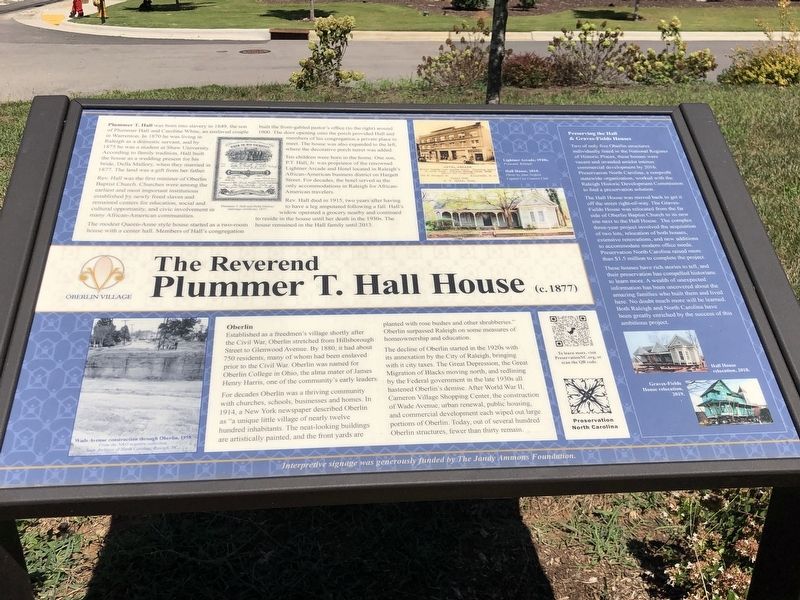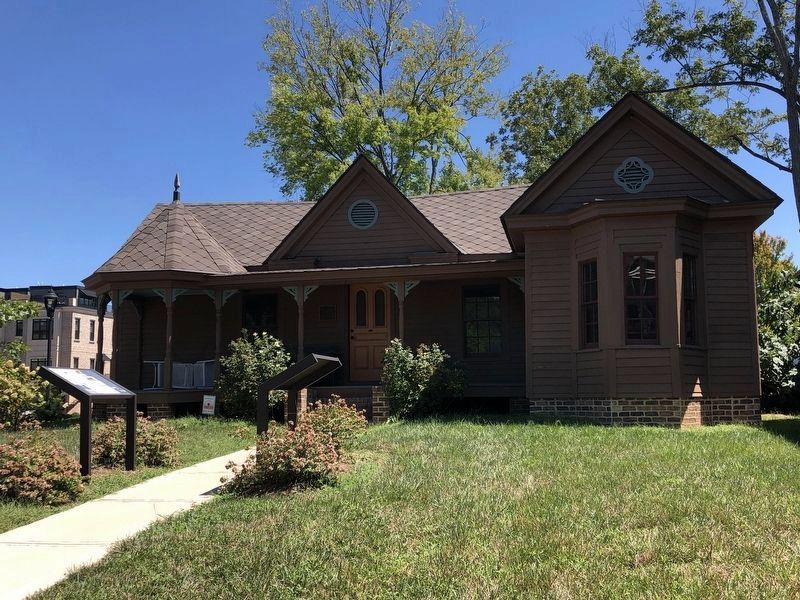Oberlin Village in Raleigh in Wake County, North Carolina — The American South (South Atlantic)
The Reverend Plummer T. Hall House
c. 1877
Inscription.
Plummer T. Hall was born into slavery in 1849, the son of Plummer Hall and Caroline White, an enslaved couple in Warrenton. In 1870 he was living in Raleigh as a domestic servant, and by 1875 he was a student at Shaw University. According to family tradition, Hall built the house as a wedding present for his bride, Della Mallory, when they married in 1877. The land was a gift from her father.
Rev. Hall was the first minister of Oberlin Baptist Church. Churches were among the earliest and most important institutions established by newly freed slaves and remained centers for education, social and civic involvement in many African-American communities.
The modest Queen Anne-style house started as a two-room house with a center hall. Members of Hall's congregation built the front-gabled pastor's office (to the right) around 1900. The door opening onto the porch provided Hall and members of his congregation a private place to meet. The house also was expanded to the left, where the decorative porch turret was added.
Ten children were born in the home. One son, P.T. Hall, Jr., was proprietor of the renowned Lightner Arcade and Hotel located in Raleigh's African-American business district on Hargett Street. For decades, the hotel served as the only accommodations in Raleigh for African-American travelers.
Rev. Hall died in 1915, two years after having to have a leg amputated following a fall. Hall's widow operated a grocery nearby and continued to reside in the house until her death in the 1930s. The house remained in the Hall family until 2013.
Oberlin
Established as a freedmen's village shortly after the Civil War, Oberlin stretched from Hillsborough Street to Glenwood Avenue. By 1880, it had about 750 residents, many of whom had been enslaved prior to the Civil War. Oberlin was named for Oberlin College in Ohio, the alma mater of James Henry Harris, one of the community's early leaders.
For decades Oberlin was a thriving community with churches, schools, businesses and homes. In 1914, a New York newspaper described Oberlin as “a unique little village of nearly twelve hundred inhabitants. The neat-looking buildings are artistically painted, and the front yards are planted with rose bushes and other shrubberies.” Oberlin surpassed Raleigh on some measures of homeownership and education.
The decline of Oberlin started in the 1920s with its annexation by the City of Raleigh, bringing with it city taxes. The Great Depression, the Great Migration of Blacks moving north, and redlining by the Federal government in the late 1930s all hastened Oberlin's demise. After World War II, Cameron Village Shopping Center, the construction of Wade Avenue,
urban renewal, public housing and commercial development each wiped out large portions of Oberlin. Today, out of several hundred Oberlin structures, fewer than thirty remain.
[Sidebar]
Preserving the Hall & Graves-Fields Houses
Two of only five Oberlin structures individually listed in the National Register of Historic Places, these houses were vacant and stranded amidst intense commercial development by 2016. Preservation North Carolina, a nonprofit statewide organization, worked with the Raleigh Historic Development Commission to find a preservation solution.
The Hall House was moved back to get it off the street right-of-way. The Graves-Fields House was relocated from the far side of Oberlin Baptist Church to its new site next to the Hall House. The complex three-year project involved the acquisition of two lots, relocation of both houses, extensive renovations, and new additions to accommodate modern office needs. Preservation North Carolina raised more than $1.5 million to complete the project.
These houses have rich stories to tell, and their preservation has compelled historians to learn more. A wealth of unexpected information has been uncovered about the amazing families who built them and lived here. No doubt much more will be learned. Both Raleigh and North Carolina have been greatly enriched by the success of this ambitious project.
[Captions (clockwise from top left)]
• Plummer T. Hall and Della Mallory marriage certificate, 1877.
• Lightner Arcade, 1920s. Postcard, Raleigh
• Hall House, 2010. Photo by Alan Neifield, Capitol City Camera Club
• Hall House relocation, 2018.
• Graves-Fields House relocation, 2019.
• Wade Avenue construction through Oberlin, 1958. From the N&O magazine collection, State Archives of North Carolina, Raleigh, N.C.
Interpretive signage was generously funded by The Jandy Ammons Foundation.
Erected by Preservation North Carolina.
Topics and series. This historical marker is listed in these topic lists: African Americans • Architecture • Settlements & Settlers. In addition, it is included in the National Register of Historic Places series list. A significant historical year for this entry is 1877.
Location. 35° 47.716′ N, 78° 39.662′ W. Marker is in Raleigh, North Carolina, in Wake County. It is in Oberlin Village. Marker is at the intersection of Oberlin Road and Oberlin Village Drive, on the right when traveling north on Oberlin Road. Touch for map. Marker is at or near this postal address: 814 Oberlin Rd, Raleigh NC 27605, United States of America. Touch for directions.
Other nearby markers. At least 8 other markers are within walking distance of this marker. The Graves-Fields House (here, next to this marker); George Thomas Morris and Snoopy (within shouting distance of this marker); Oberlin Village (about 400 feet away, measured in a direct line); Latta University Site: 1892-1922 (about 600 feet away); Oberlin Cemetery (approx. 0.2 miles away); Holt Family (approx. 0.2 miles away); Sitdowns (approx. 0.4 miles away); North Carolina State University at Raleigh (approx. 0.6 miles away). Touch for a list and map of all markers in Raleigh.
Also see . . . Rev. Plummer T. Hall House (PDF). National Register nomination submitted for the house, which was listed in 2002. (National Archives) (Submitted on September 22, 2023, by Duane and Tracy Marsteller of Murfreesboro, Tennessee.)
Credits. This page was last revised on September 22, 2023. It was originally submitted on September 22, 2023, by Duane and Tracy Marsteller of Murfreesboro, Tennessee. This page has been viewed 68 times since then and 23 times this year. Photos: 1, 2. submitted on September 22, 2023, by Duane and Tracy Marsteller of Murfreesboro, Tennessee.

